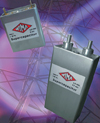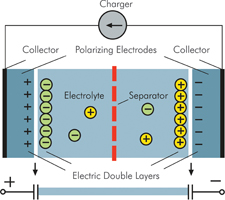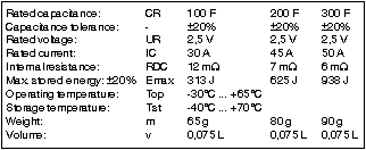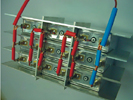
Passive components, especially capacitors, are today undergoing constant development and so make an indispensable contribution to technical progress in electronics. Every day we use innovative technical solutions in communications, in transport, medical technology and for leisure-time activities. An increasing number of new functions are controlled, steered or even just made possible by electronics.
One of the most recent innovations in the field of passive components is the electrochemical double layer capacitor - the SuperCapacitor from Wima. From about 10 up to several thousand farad (F) values are housed in one case (Figure 1). A 100 F model, for example, is approximately the size of a match-box, and this capacitance would correspond to the impressive volume of 100 million parallel connected standard polyester film capacitors with an individual capacitance of 1 mF each! With the SuperCapacitor, despite the limitations of its low maximum operating voltage of 2,5 V, several units can be built up to an enormous capacitance of the desired voltage rating by connecting them in series or parallel (cascade).

A typical application is for the quick supply of several hundred amperes in the direct current field. The SuperCapacitor is therefore, the connecting link between a conventional capacitor and a battery. It combines the advantage of the capacitor as a fast supplier of electricity with that of the battery, as a notable energy reservoir. Its energy density is, at present, still limited to about 1/10th of the battery value - thus far!
The working principle of the electrochemical double layer capacitor was discovered by the physicist von Helmholtz as early as 1856. He described the phenomenon of the construction of a double layer made up of charge carriers, which are formed on electrodes in a conductive liquid when voltage is applied. It was not until the middle of the 20th century that some scientists looked at the Helmholtz model again in order to see to what extent it could be used for the realisation of technical capacitors.
At the beginning of the 1980s the Japanese were the first to succeed: with the so-called 'Gold Cap', a thumb-sized unit with a capacitance of 10 F. It was first used for voltage support on computer boards. In the meantime other manufacturers, including Wima, are now active in this field.
The double-layer capacitor
Building on the Helmholtz principle of energy storage, Wima's SuperCap capacitors have about a million times the capacitance of traditional capacitors of comparable size. These SuperCaps can accumulate energy comparable to the stored energy of smaller batteries, however, they deliver considerably higher electric currents and are also maintenance-free.
By the use of a material based on an electrode containing carbon, which is attached with low resistance to a conductive foil, the SuperCap achieves extremely large surfaces within the smallest volume.
For technical enthusiasts, it should be mentioned that the secret of its comparably enormous capacitance is to be found in its material construction and working principle (Figure 2). The capacitance rate of the well-known plate capacitor (from the physics lesson) is determined by the: size of the plate or electrode; the small distance between the plates; and the dielectric value of the insulator material in between. In the case of the SuperCap, the inner surface accessible to the charge carriers (its electrode surface), is extremely large, as it takes the form of a carbon-layered electrode. Casually speaking, the inner surface would cover a whole football stadium. The strength of the dielectric, resulting from the electrochemical double layer, is, on the other hand, tiny - it corresponds to half the diameter of an ion. The double-layer itself consists of ions which, when voltage is applied, attach to the positive or negative electrode corresponding to their opposite poles and creates a dielectric of only a few angstrom. According to the formula for the capacitor; from the dielectric constant of the double layer of about 40, the extremely thin dielectric, as well as the extremely large surface area, the result is a very high capacitance yield.

Wima double-layer capacitors are available in the standard capacitance range of 100 F to 300 F with a rated voltage of 2,5 V d.c. and the highest discharge current (see Table 1). The prismatic case makes space-saving serial and parallel connections possible. Wima SuperCaps can replace, protect or support batteries eg, in the context of new traction technologies.

Application of double layer capacitors
The areas of use for SuperCapacitors conform to the most modern developments in power electronics and their application. In general, they are used for voltage support, for the fast supply of electric energy, eg, to cover the requirements of peak power demand, or for the saving of batteries, which can then be made smaller, as the capacitor lowers the peak current.
A frequent use of the SuperCap is to be found in the consumer field: a bicycle is standing in the dark, for example, at a red traffic light. To protect the cyclist, the lights remain active while the bicycle's dynamo is still. A small SuperCap supplies energy to the front and back lights for several minutes.
The SuperCap has just entered use in uninterruptable power supply (UPS). In the simplest case it supplies the emergency generator, usually a diesel generator or a micro-turbine, with the necessary start-up energy completely maintenance-free. Even alone, in special cases, it can mitigate short-term and tiny voltage dips when connected to the grid. More than 90% of the dips in mains are shorter than 10 seconds.
In a recently-described telecoms application, SuperCaps supply emergency energy to switch-over base stations for mobile phones. The best thing about these systems is their lack of maintenance and their reliability. The numerous stations have to be able to interrupt safely in the case of power failure and to restart automatically.
Also, in the generation of wind power, special demands are made on interruption-free electricity supply. Wind turbines use pitch control on the blades, which ensures that the rotation speed of the blades remains constant. Especially in a storm, they must not over-rotate, and so using pitch control, the rotor blades are twisted to lose or gain traction. This control must function self-sufficiently on each windmill, in all weathers, at temperatures between -40°C and +70°C, always and for many years to come. The use of SuperCaps in the windmills considerably reduces maintenance work, and can also help increase profitability.
There is now a lot of discussion about new types of traction systems for motor vehicles. Manufacturers world-wide are working on vehicles with fuel cell drives. In state-of-the-art technology, the portable fuel cell works most reliably in a continuous manner. Some manufacturers pin their hopes on load-levelling, by means of a power reservoir in parallel. To put it simply: an array of several SuperCapacitors that are resilient due to their lowest internal resistance and their low weight, are therefore predestined for this purpose.
A further advantage of the SuperCapacitor in the car, when electric drive is being used anyway, is the possibility of recuperating brake energy. Up to 80% of the kinetic energy that is usually wasted by stopping for traffic lights, can be collected in the SuperCaps and later, be made available for driving again.
For railways, SuperCaps can be used as a reliable start for diesel-electric locomotives.
An ideal case for the use of double-layer capacitors as an energy buffer is to be found in photovoltaic conversion. In countries that are blessed or plagued by eternal sun, the advantage of a completely independent, permanently available and largely maintenance-free energy converter is obvious: as long as the sun shines, the capacitor is charged via the photocell.
Wima quality
The Wima double-layer capacitor is excellently suited for all these applications. Its low capacitance drift over and beyond its lifetime guarantees that the electric function is maintained for decades. Careful studies show that the Wima SuperCap renders its service reliably even under the hardest conditions. Its metallic rectangular case is tightly sealed by laser welding and therefore handles the most severe temperature fluctuations. The Wima SuperCap copes with short-term over-heating, which in other system solutions, can cause undesirable problems in application. Its prismatic shape allows for a greater packing density - avoiding unused cavities. Where natural cooling is not sufficient eg, in the case of fast pulse sequences, permanent over-heating can be prevented by a ventilator.
Wima performs constant quality assessments. In tests of the different types, the usual running-in of the capacitance for double layer capacitors is recorded. For this purpose, the Wima SuperCaps are subjected to tens of thousands of charging and discharging cycles. The enormous inner surface structure is typically reduced on first use only by about 10%. After that the capacitance remains constant even with higher temperature applications. The user can thus be sure of a lifelong stable function. The run-in is compensated by a capacitance tolerance of 20% depending on type. It is thus guaranteed that the capacitance given on the performance label is actually available.
A further test is carried out on a series/parallel connection of several double-layer capacitors, for example on 300 F at 7,5 V. Due to the prismatic structure of the Wima capacitor, much space can be saved in the construction of the series/parallel connection (Figure 3). For a more demanding load, it is recommended that the SuperCaps be fixed by means of metal plates.

At Wima, the individual capacitors are tested according to DIN recommendations for capacitors of this type.
Conclusions
Generally speaking, the time is ripe for the Helmholtz capacitor. Its success cannot yet, of course, be chalked up en masse. However, the environmental awareness that has set in increasingly in recent years, the current discussion about energy consumption and the explosion of fuel prices are grist to the mill of the SuperCap. The looming change in the climate, whatever it is caused by, is reinforcing acceptance of new resource-protective technologies.
Here the Wima SuperCap is to be found in the front line, because it makes a revolutionary contribution to the increase of efficiency in the use of electric energy. Its application in combination with alternative traction may also be seen in this respect. Increasingly rigorous exhaust emission regulations are driving this development forward. Thus, the boom of these new technologies in the field of passive components corresponds to the prognoses for the coming years.

© Technews Publishing (Pty) Ltd | All Rights Reserved